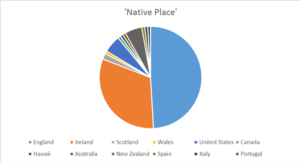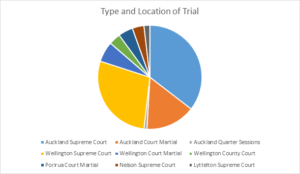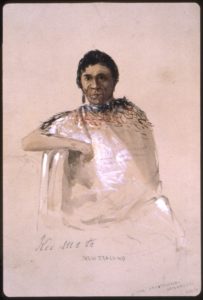Research Brief 31
In October 1841, William Phelps Pickering became the first person sentenced to transportation from New Zealand. His seven year sentence was handed down at the first Quarter Sessions ever held in Auckland after Pickering was found guilty of fraud and misrepresentation.
It was one thing for a New Zealand court to hand down a sentence to transportation, but another – legally and logistically – for it to be carried into effect. The month after Pickering was sentenced, Governor William Hobson proclaimed Van Diemen’s Land as the site to which convicts could be transported from New Zealand. His administration then had to contract the owner of an inter-colonial trading vessel to convey the prisoner to the penal colony. Over the following decade, small ships plying the trade routes between New South Wales, Van Diemen’s Land, and New Zealand carried prisoners from Auckland and Wellington to Hobart, accompanied by police guardsmen.
Convict indents, conduct records, court and newspaper reports, and colonial correspondence confirm that at least 109 men and one woman were transported from New Zealand to Van Diemen’s Land between 1842 and 1853. These records, particularly the indents held in Tasmania, reveal fascinating micro-histories that not only detail the prisoners’ life courses but also highlight processes of British colonisation. Through meticulously recording the prisoners’ ‘native place’ or places of origin, for example, colonial clerks reveal how New Zealand’s population in the 1840s and early 1850s was culturally and ethnically diverse.
 This disrupts the British coloniser/Māori colonised binary that tends to characterise New Zealand colonial history. Such a binary perspective fails to take account of the presence of men such as Heke, a Hawaiian sentenced in the Auckland Supreme Court on 4 March 1851 to transportation for life, or Emmanuel Lewis, a black cook originally from Spain who arrived in New Zealand via America before being sentenced on 20 September 1844 to transportation for ten years.
This disrupts the British coloniser/Māori colonised binary that tends to characterise New Zealand colonial history. Such a binary perspective fails to take account of the presence of men such as Heke, a Hawaiian sentenced in the Auckland Supreme Court on 4 March 1851 to transportation for life, or Emmanuel Lewis, a black cook originally from Spain who arrived in New Zealand via America before being sentenced on 20 September 1844 to transportation for ten years.
Tellingly, almost half of those transported from New Zealand to Van Diemen’s Land were currently serving or former British soldiers. Many of these men ended up in the Antipodes after serving as guards on convict transports between Britain and the Australian penal colonies. Some were redeployed to New Zealand in the 1840s following the outbreak of the Northern Wars in the far north of the North Island and the Lower Hutt War near Wellington. Of the 51 soldier convicts transported to Van Diemen’s Land, 24 faced a court martial. The remaining 27 were tried civilly, some because they had already left the military and others because they had deserted but then committed crimes such as larceny while on the run.
The majority of those sentenced to transportation either deserted or committed offences designed to engineer their removal from the theatre of war. At least one admitted on his arrival in Hobart to having been scared of Māori fighting men. One of the first redcoats transported from New Zealand, Private Richard Shea of the 99th Regiment, was sentenced to transportation for life following a court martial in Auckland on 9 May 1846 at which he was found guilty of having ‘struck Lieutenant Johnson at Porirua’, an act he later described as having been carried out using his firelock when on parade. In a similar incident in which a soldier struck Judge Henry Chapman in Wellington, it was widely thought that the redcoat desired to be transported. He was flogged instead.
The types of trial that those sentenced to transportation faced, and the locations at which these trials were held, reflect the spread of colonisation and intensity of resistance to it, and also chart the imposition of English-derived colonial law across New Zealand..
On the other side of the frontier, at least six Māori, including Te Kumete, were transported to Van Diemen’s Land, five after being court martialled in relation to their involvement in the Lower Hutt War and one as the result of a civil trial. Neither the court martial nor the civil trial included Māori adjudicators. However, unlike in the Australian colonies where Aboriginal people were involved almost solely as defendants in the court system, New Zealand had a long history of Maori involvement at the bench. In June 1842, for example, when Edmund Halswell heard a case against two Māori, Te Kopo and E Pokai accused of stealing pork, a chief known as ‘Turingha Kuri’ (Taringa Kuri/Te Kaeaea), sat at the bench with the judge. Māori involvement in helping to dispense colonial justice in New Zealand had a long lineage dating back to a proclamation of 9 November 1814 in which the governor of New South Wales, Lachlan Macquarie appointed the missionary Thomas Kendall as resident magistrate at the Bay of Islands and also named Ruatara, Hongi Hika and Korokoro as magistrates in New Zealand.
Margaret Reardon, a 26 year old dressmaker originally from Ireland who arrived free in Auckland via Sydney, was the sole female sentenced to transportation from New Zealand. She was convicted of perjury at the Supreme Court in Auckland in September 1848, and was probably fortunate to have escaped murder charges, after having falsely accused two men of committing a murder for which her de facto husband was later hanged. The marked gender disparity evident in relation to sentences to transportation can be explained by the fact that very few women were charged with serious crimes in early colonial New Zealand. As Megan Simpson pointed out, only seven female defendants (including Reardon) appeared before the colony’s Supreme Court in the 1840s and it was solely this higher court that dispensed sentences to transportation following its founding in 1842.
Author: Kristyn Harman
Further Reading: Kristyn Harman, 2017. Cleansing the Colony: Transporting Convicts from New Zealand to Van Diemen’s Land. Dunedin: Otago University Press; Megan Simpson, 2010. “R v Margaret Reardon, Supreme Court Auckland, 1 September 1848”, Victoria University of Wellington Law Review (41), 99–106; Robert Burnett, 1978. Penal Transportation: An Episode in New Zealand History. Wellington: Victoria University of Wellington; Terry Carson, 2016. The Axeman’s Accomplice: The True Story of Margaret Reardon and the Snow Family Murders. Auckland: Alibi Press, 2016.
To cite this Research Brief: Kristyn Harman, ‘Convict Micro-Histories Reveal Processes of British Colonisation’ The Prosecution Project, Research Brief 31, https://prosecutionproject.griffith.edu.au/convict-micro-histories/(28 Jul 2018, viewed 29 Jul 2018).

